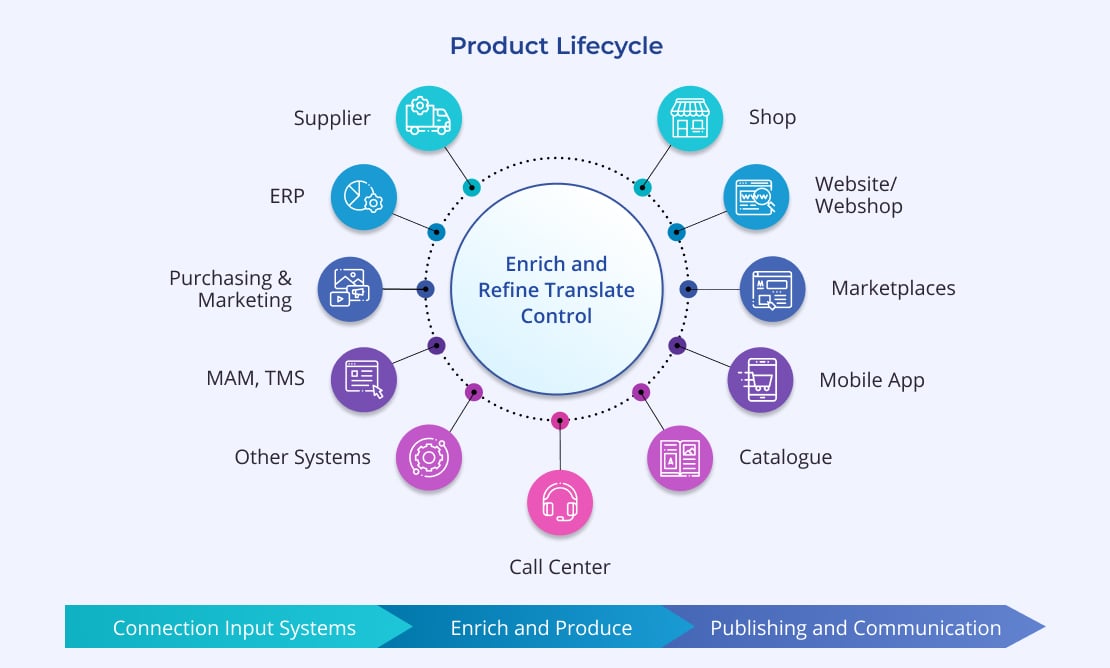Product Information Management Trends
Digital solutions open up new opportunities that allow e-Commerce businesses to better engage their customers and increase sales.

Aside from facilitating the shopping process for customers, such digital diversity also raises new challenges for marketers, making competition in the e-Commerce sector much more complex. Now, businesses require sophisticated supportive marketing instruments and techniques to present consistent and exciting product data to their buyers. They include product information management practice (PIM) and various digital PIM tools and systems.
In this article, we explain the reasons why PIM software is quickly growing in popularity and what are the main trends and best practices in product information management. Though, if you need to find out more about PIM, read our comprehensive guide “What Is Product Information Management?” that addresses the core aspects of PIM that you need to know.
The Market for PIM Software Is Exploding
PIM software is on the rise now.
 This almost 6 times increase is explained by a booming growth of the e-Commerce sector which started with the Covid-19 pandemic and is still continuing. The e-commerce market share is expected to reach $6.38 trillion by 2024 in comparison to $4.28 trillion in 2020.
This almost 6 times increase is explained by a booming growth of the e-Commerce sector which started with the Covid-19 pandemic and is still continuing. The e-commerce market share is expected to reach $6.38 trillion by 2024 in comparison to $4.28 trillion in 2020.
The necessity to gather and effectively organize product information led to strong demand for PIM software, especially in large enterprises. The PIM systems allow large-scale businesses to manage data for a variety of brands and products much easier, standardizing the content for multichannel marketing and boosting marketing team productivity. This intense interest in PIM solutions on the part of large enterprises is expected to dominate the entire product information management market size for several years, though by 2027 the share of SMEs that use PIM solutions will also rise significantly.
The Key Role of Product Information Management Systems

In 2022 to these goals, marketers will have to add the provision of a complete product experience across multiple channels.
Using product information management systems, businesses can raise product awareness and provide valuable experience customers and diverse sales partners expect from them. Here are the key PIM functions that place PIM systems among the most effective digital marketing tools.
Data Unification
A product manufacturer has to share its product information with various types of sales partners. They include distributors, wholesalers, retailers, marketplaces, and others. All of them have their own product requirements and data standards. With PIM software, marketers can save up plenty of time, providing the needed data in the right formats and languages and avoiding tedious manual data adjustments.
Provision of Detailed Product Data
Often, manufacturers put on the market more than one type of product. Many of them, like Pfizer, Nestle, Unilever, and others have more than 10 brands each with its own line of products. These companies have to store all the data on each product type in a unified system and have quick access to it. PIM systems can easily handle this issue by providing manufacturers with well-structured and simple to manage catalogs that store and provide detailed descriptions swiftly.
Improved Customer Experience
A common strategy for online and offline buyers is to search for data on a product they want to purchase online. Scarcity of information, e.g. unclear pricing is one of the reasons for shopping cart abandonment. PIM systems provide accurate and up-to-date information, ensuring better customer experience and reducing the cases when buyers lose interest in the purchases.
Boost of Marketing Team Efficiency
PIM systems automate many repetitive tasks such as data import and export, setting up product taxonomy, data validation. Moreover, in most cases, they simply integrate with other business software and provide one place for content creation, storage, and enrichment. All these activities help marketing teams to work efficiently and quickly create and share product data with other companies, customers, or sales partners.
Top Product Information Management Trends and Best Practices
When businesses consider integrating PIM software in their digital infrastructure, they want an easy to scale, intuitive, and equipped with the most prominent tools system. For this reason, many companies turn to bespoke software development companies and build custom e-commerce solutions, including PIM apps, that entirely meet their business needs.
Aside from fulfilling a particular company’s demands, effective and robust PIM software should also follow the latest marketing trends and best practices. Here are the top trends PIM software should follow in 2022:
- Easy data management
A modern PIM app should be able to handle a wide variety of data. It means not only exporting and importing information in different data formats like CSV or XML, but being able to extract data from remote locations and automatically update it, provide the possibility to amend any data and perform automatic status updates, receive large data volumes from different sources, and much more.
- Seamless integration
For companies, it’s critical that they can integrate their PIM software in the existing business digital ecosystem. Therefore, this type of software needs to have robust APIs that can smoothly connect with any business systems such as enterprise resource planning (ERP), order management systems (OMS), point of sale systems (POS), marketing apps, and others.

Product data syndication
An effective PIM system should accurately prepare and syndicate product details and share them with the company’s supply chain participants. Merchants and manufacturers can use the syndicated data for various marketing channels, including marketplaces, mobile apps, social media, kiosks, and others. For this, the PIM solution should be able to adjust the data to the needs of a particular marketing channel, provide instruments to create unique customer journeys, push the right product data on the corresponding marketplaces, provide tools for effective advertising, and much more.
- Improved data validation
Providing high-quality data is essential for an advanced PIM system. Therefore, e-Commerce software developers need to ensure that they build a trusted single source of truth in their PIM solution. It means that the data is carefully gathered from various sources to a single location, it’s well-structured and verified. For this, software developers have to integrate robust data analytics features that can organize data in a hierarchy, clean it up, parse it in bullets and descriptions, optimize data for omnichannel commerce, provide text format data validation, and much more.
Conclusion
Rapid digitization and a quickly growing number of online buyers have triggered a boosting growth of the E-Commerce industry. To keep up with the e-Commerce development pace and meet their customer demand 100%, e-Commerce companies have to constantly experiment and integrate new digital technologies in their business operations.
One of the recent innovations that can help businesses prioritize their brands, raise their product awareness, and provide a comprehensive product experience across multiple marketing channels is the deployment of product information management systems. They allow companies to precisely analyze, structure, and validate their brand and product data and share it with all the supply chain participants swiftly and in the appropriate formats.












